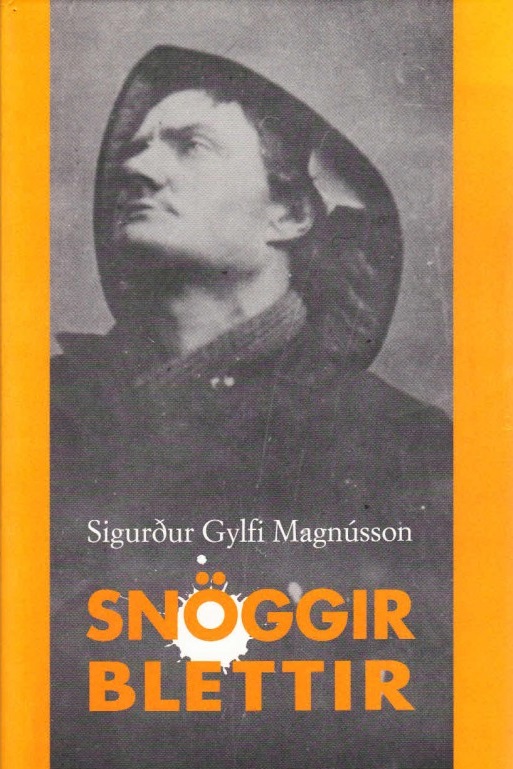 Soft Spots. Published by the Center for Microhistorical Research and The Reykjavík Museum of Photography, 2004. 141 pages – (Snöggir blettir (Reykjavík, 2004)).
Soft Spots. Published by the Center for Microhistorical Research and The Reykjavík Museum of Photography, 2004. 141 pages – (Snöggir blettir (Reykjavík, 2004)).
For a long time I did not understand why my grandfather collected photographs of strangers; I could not see the point of it, and was quite unable to fathom this passion.
That was at the time when social history was opening up its embrace towards young historians, with its quantitative approach that shunned the atypical factors that did not comply with demographers’ means and averages – the “outliers.” The 1970s and 80s were the time of the broad brush in social analysis – systems or structures to which human activities were adapted, on the principle of demonstrating how the mass of the population lived their lives.
And the years passed. Now and then I would handle my grandfather’s collection, leaf through it, though without experiencing any revelation about the content. For most of the time the collection was left in a drawer to gather dust, while the heavy wheels of social history rumbled on.
In 1999 an Icelandic publishing house decided to invite scholars at the Reykjavík Academy and some of the authors on its list to select a photograph and write something about it. The results would be published in book form. I was at that time chair of the Reykjavík Academy, and I was keen to be part of the project; I knew immediately what photograph I would choose. It was from my grandfather’s collection: a photograph of a man known as “Rat” Petersen.
The text I wrote about “Rat” Petersen would be the beginning of something more: at that point I understood the value of the photographs; I felt I grasped my grandfather’s motivation better than before. That was at the time when the grand narrative approach to history was on the brink of collapse; its importance, at least, was greatly reduced, and many scholars within the humanities started to consider where their research stood in the scholarly context. That process sparked a development in my thinking which opened my eyes to the opportunities my grandfather’s photographs offered. I started writing about more of the pictures, which in due course formed the backbone of the book Snöggir blettir (Soft Spots), published in 2004.
Soft Spots takes account of one aspect of the “Slow” ideology, although the Slow concept is not specifically addressed in the book. In it I explore the circumstances which imbued with meaning the “soft spots” in people’s personalities. The book is fiction from start to finish: a historian’s fiction, grounded in my feel for the subject, and the approach I deemed necessary in order to display the conclusions I had reached – conclusions which must be deemed quite unscientific, but fall within the framework of the ‘evidential paradigm.’ I cast the book in the form of autobiography, a form I have been working with in the scholarly context in recent years, in the field of egodocuments. This non-autobiography is based upon the above-mentioned photographic collection of my grandfather Helgi Magnússon (1872-1956), a blacksmith and merchant in Reykjavík, who over decades accumulated photographs of vagabonds and outsiders, individuals who were well known in Icelandic society for their unconventional lifestyles and behavior. The collections grew over the years to be quite considerable. My father, Magnús Helgason (1916-2000), the manager director of an industrial firm in Reykjavík, told me that Grandfather Helgi had been in the habit of sitting over his collection for hours, and enjoyed leafing through the pictures. This “archive” was passed on to me in 1980, at the time when I was commencing my history studies at university. My father probably saw it as appropriate that the pictures should be committed to my care, since I was pursuing such study; he himself had an interest in Icelandic “folk knowledge” and drew no firm distinction between such informal learning and formal historical scholarship.
My idea for the book (quite apart from my obvious personal perspective on my grandfather’s “archive”) was quite simply to explore what kind of knowledge can be applied when a single source – an archive, document, letter, illustration, etc. – is examined, and whether the knowledge derived may not be quite as good in its own context as in the broader perspective. This methodological experiment of the book was assuredly part of my microhistorical development and approach, especially that which compels the scholar to scrutinize the subjective context, to temper the researcher’s grandiosity, slow down the research process and give oneself time to consider factors which generally make no impression on the person analyzing and exploring. In that sense the text of the book is an improvisation based on the materiality of the photographs and the effects they produce. Guided by such ideas I produced the book, placing myself within the framework laid out there.
My discussion of the photographs is framed to resemble conventional chapters of autobiographies, which I have connected together by invented letters: one supposed to have been written by my grandfather to my father on his birthday, 24 November 1938, when he was a student in Berlin; another purportedly written to me by my father on the same date in 1993; and a letter I imagined writing to the future, once again on 24 November, in 2000, shortly after my father’s death. All the letters are “true” in the subjective sense, based on collective family memory.
Soft Spots is an ode to certain conditions that go to shape the world – possibly peripheral cultures, or the boundary between different worlds. Which individuals find themselves excluded? And what is the contribution of people in that situation to the society which in some sense rejects their existence? What is the relationship between scholarship and people in this context? What is the impact of researchers’ priorities on our perception of society? I realized that this particular archive offered me the opportunity to consider the above-mentioned questions, and on entirely different premises from my previous work.
What have we in the present day lost of the vision of such individuals who lived between different cultural world? Their perspective clearly differed from that of the majority of their contemporaries, and their interpretation of such concepts as freedom, justice, time and speed was unlike that of those who pursued a conventional bourgeois life – those who were constantly hurrying from A to B, and whose philosophy of life would lead the way to fast food, freeways and modern consumerism.
Some of this appears to have made its impression on my grandfather, the pillar of the community, who apparently gave it some thought in his own quiet manner. For myself, on the other hand, I did not properly grasp the importance of the pictures until I walked one day down a corridor of the Reykjavík Academy, and contemplated large pictures of vagabonds, hung on the wall by artist Birgir Andrésson as part of a work of art. Like my grandfather, Birgir was interested in this group of outsiders, and their values informed his art. As I walked down the 78-metre-long corridor of the Reykjavík Academy, where photographs of vagabonds had ben lined up along the walls, I grasped for the first time in earnest the significance of these people, and the emptiness that the speed of modern life tends to induce. Each photograph was displayed at more than life size, and I had the sense of being in the middle of a tale of eccentrics – one form of the local tale tradition in Iceland. The reason why I had not previously noticed their significance is that the concept of sensitive points has never been on the agenda of those who follow the model of the grand narrative – the big structures that govern perceptions of reality. Soft Spots is an attempt to capture that emotional journey in words and pictures. The book is grounded in “Slow” principles, i.e. allowing oneself the indulgence of exploring the crumbs that have fallen from the scholarly table, where the focus has been on sharpening the outlines of scholarly knowledge.
